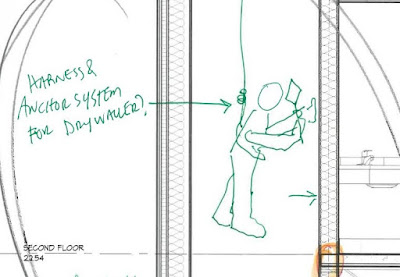Designing for Others
In a sense, architecture is always about designing for others, is it not? Even if I designed a home or structure for "myself": as a married person with children, wouldn't I ultimately take the needs of my family into consideration? Unless I was designing a domicile for which I intended to occupy in solitude so that I could devote my time to a great work of literature (clearly I am not talking about this blog), would I not consider visitors? Even Thoreau's Walden: Life in the Woods devotes a chapter to the comings and goings of visitors (he always had three chairs ready for visitors). We are never truly alone.
As it turns out, nearly all that I do revolves around design for others. In my position as one of the "Checker of Drawings", I essentially become a method actor playing several roles as I read "the script". The script, or the collective of the construction documents, as it were, is strictly a draft when I read it. Depending on which act I am reading, I immerse myself into the character suitable for the role.
First, I become the Code Official. I am likely seeing this set of documents for the first time. Even if I know a lot about the project, I pretend I do not. The Code Official must be able to review the first several pages of a set and get a general understanding of the existing conditions (if there are any), the type(s) of building(s) proposed, the occupancy, the construction type, the amount of area and height, etc. A lot to do, and it is a challenge to do this clearly and succinctly. Are there fire walls, and if so, where? How much renovation is there (Level 2 or Level 3)? Where are the different uses separated? We have to come up with a way to convey this information even if it means adding little drawing vignettes to clarify.
Next, I try to take the point of view of the people building this structure. How clear are all the transitional details - are there enough blow-ups? Are the required dimensions there? Even if the dimensions are there, are they in the right place, where they make sense to the builder? How have the details considered the person physically putting the drywall on the wall? We also try to incorporate all of the systems and engineering knowledge to coordinate consultant drawings; so that our drawings don't say one thing, and the electrical drawings say another.There are so many things to consider that, unless you do the same building over and over again, no one would ever catch them all. But we try none-the-less and strive to be better all the time.
 |
| Much of what I look for is not glamorous, however stairway enclosure protection is important, especially if missed and not considered during design prior to bidding. |
 |
| Sometimes, the things I look for are mundane, like how does this tiny shaft get drywalled up three stories? |
 |
| Sometimes, when I see the same issue over and over, I need to keep myself sane... |
 |
| A reception desk in a senior's environment needs to consider, in all aspects, the perspective from a wheelchair. |
 |
| Always remember, staff break rooms cannot be considered "employee work areas"! |
This post is part of the ArchiTalks series where a group of us (architects who also blog) all post on the same day and promote each other’s blogs. This month’s theme is "Designing for Others" and was led by Jeff Pelletier. A lot of other talented writers who also are architects are listed below and are worth checking out:
Jeffrey Pelletier - Board & Vellum (@boardandvellum)
How To Design for Others
Lee Calisti, AIA - Think Architect (@LeeCalisti)
designing for others – how hard could it be?
Michele Grace Hottel - Michele Grace Hottel, Architect (@mghottel)
"designing for others"
Keith Palma - Architect's Trace (@cogitatedesign)
Just say no
Mark Stephens - Mark Stephens Architects (@architectmark)
Designing for others
Steve Mouzon - The Original Green Blog (@stevemouzon)
Planting Seeds of Better Design
Anne Lebo - The Treehouse (@anneaganlebo)
Designing for people

No comments:
Post a Comment
Note: Only a member of this blog may post a comment.